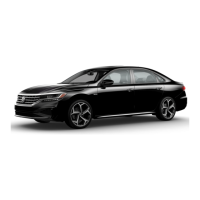The system cannot be used to prevent accidents
and serious injuries. The system cannot
to replace the driver's attention.
•
Always adapt the speed and the distance to
the vehicle in front according to visibility,
weather, road and road conditions.
and traffic.
•
Never use ACC in poor visibility, on steep,
winding or winding roads (e.g. in case of snow,
ice, rain, etc.).
or loose gravel), nor on flooded roads.
•
Never use the ACC off-road or on roads that
are not paved. The ACC is intended for use on
paved roads only.
•
Immediately take control of the vehicle when
an indication is shown on the instrument panel
display or if the vehicle is in a state of disarray.
ACC does not reduce speed sufficiently.
•
Brake when the vehicle rolls unintentionally,
e.g. after the driver has been requested to
intervene.
•
Always be prepared to regulate yourself.
mo the speed.
Introduction to the topic
The adaptive cruise control (ACC = Adaptive
Cruise Control) maintains a constant speed set
by you. When the vehicle approaches a
vehicle in front, ACC automatically adapts the
speed to the vehicle in front.
and thus maintains the distance set by you.
Adaptive Cruise Control
(ACC)
How to find out if the vehicle has ACC
The vehicle is equipped with ACC if settings for this
system can be made in the infotainment system's
assistants menu.
Speed range
You can set a speed between 30 km/h
(20 mph) and approx. 210 km/h (130 mph); in the
USA, up to approx. 150 km/h (95 mph). This range
may vary depending on the market.
Driving with ACC
You can override ACC control at any time. If you
brake, control is interrupted. If you accelerate,
control is interrupted for the duration of the
acceleration and then resumed.
Request for driver intervention
If ACC's automatic deceleration is not
sufficient or the system limits have been
reached, ACC prompts you to brake further
by means of a message in the instrument
cluster. In addition, the red warning lamp
lights up and an acoustic warning sounds.
Take control of the vehicle and be ready to
brake!
Radar sensor
ACC detects driving situations by means of a radar
sensor at the front of the vehicle. The range of this
sensor is approx. 120 m (approx. 400 ft).
Special walking situations
Please note at the beginning of this chapter
on
page 127.
Overtaking
When you switch on the left indicator (or right
indicator if driving on the left) to overtake, ACC
accelerates the vehicle and reduces the distance to
the vehicle in front without exceeding the speed set
by you.
If ACC does not detect a vehicle ahead after
changing lanes, it accelerates the vehicle to the
set speed.
This overtaking aid is not available in all countries.
Heavy traffic with intermittent stops
If the vehicle is equipped with an automatic
transmission, ACC can brake the vehicle to a stop
and hold it at a standstill. ACC remains active and
the instrument cluster display shows
ACC ready to
start
for a few
seconds.
As long as ACC remains active, the vehicle restarts
automatically as soon as the vehicle in front starts
driving (depending on equipment and not available in
all countries).
Intelligent ACC technology cannot overcome the
limits imposed by the laws of physics and only
works within the limits of the system. Never allow
the increased comfort provided by this technology
to lead to safety risks. If used carelessly or
unintentionally, this can lead to

